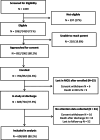Trajectories of attention problems in preschoolers born very preterm
- PMID: 39523488
- PMCID: PMC12018157
- DOI: 10.1111/jcpp.14074
Trajectories of attention problems in preschoolers born very preterm
Abstract
Background: Children born preterm are at heightened risk for neurodevelopmental impairment, including specific deficits in attention. Few studies have investigated change over time in attention problems prior to school entry. The current study aims to describe trajectories of attention problems from age 2 through 5 years in a cohort of children born <30 weeks of gestational age (GA), identify sociodemographic, medical, and neurobehavioral characteristics associated with attention trajectories, and test whether attention problem trajectories predict the risk of a reported attention-deficit/hyperactivity disorder (ADHD) diagnosis.
Methods: We studied 608 infants from the Neonatal Neurobehavior and Outcomes in Very Preterm Infants (NOVI) Study, a prospective, multisite study of infants born <30 weeks of GA. Parents reported on child attention problems at ages 2, 3, 4, and 5 years using the Child Behavior Checklist and the Behavior Assessment System for Children. Sociodemographic and medical characteristics were assessed via maternal interview and medical record review. Neurobehavioral characteristics were determined using neonatal and 2-year assessments. Parent report of child ADHD diagnosis was obtained. We used latent growth curve (LGC) modeling to test our study aims.
Results: A linear LGC model provided the best fit to the data. The average trajectory of attention problems evidenced low initial levels of symptoms and little change over time, yet there was significant heterogeneity in both initial levels and change over time. Individual differences in trajectory parameters were associated with sociodemographic, medical, environmental, and neurobehavioral characteristics. Children with higher initial levels of attention problems as well as steeper increases in attention problems over time were more likely to have a reported ADHD diagnosis.
Conclusions: There is significant heterogeneity in trajectories of attention problems from age 2 to 5 in children born <30 weeks of GA and these differences have clinical relevance. These data could inform follow-up guidelines for preterm infants.
Keywords: Attention problems; attention deficit hyperactivity disorder; preschool; preterm; trajectories.
© 2024 The Author(s). Journal of Child Psychology and Psychiatry published by John Wiley & Sons Ltd on behalf of Association for Child and Adolescent Mental Health.
Figures


Similar articles
-
Antecedents of Attention-Deficit/Hyperactivity Disorder Symptoms in Children Born Extremely Preterm.J Dev Behav Pediatr. 2016 May;37(4):285-97. doi: 10.1097/DBP.0000000000000298. J Dev Behav Pediatr. 2016. PMID: 27096570 Free PMC article.
-
Attention deficit hyperactivity disorder and autism spectrum disorder symptoms in school-age children born very preterm.Res Dev Disabil. 2018 Mar;74:103-112. doi: 10.1016/j.ridd.2018.01.001. Epub 2018 Feb 2. Res Dev Disabil. 2018. PMID: 29413425
-
Neonatal cerebral morphometry and later risk of persistent inattention/hyperactivity in children born very preterm.J Child Psychol Psychiatry. 2014 Jul;55(7):828-38. doi: 10.1111/jcpp.12200. Epub 2014 Jan 20. J Child Psychol Psychiatry. 2014. PMID: 24438003 Free PMC article.
-
Behavioral problems and cognitive performance at 5 years of age after very preterm birth: the EPIPAGE Study.Pediatrics. 2009 Jun;123(6):1485-92. doi: 10.1542/peds.2008-1216. Pediatrics. 2009. PMID: 19482758
-
Growing up after extremely preterm birth: lifespan mental health outcomes.Semin Fetal Neonatal Med. 2014 Apr;19(2):97-104. doi: 10.1016/j.siny.2013.11.004. Epub 2013 Dec 2. Semin Fetal Neonatal Med. 2014. PMID: 24290907 Review.
Cited by
-
CMRI-detected brain injuries and clinical key risk factors associated with adverse neurodevelopmental outcomes in very preterm infants.Sci Rep. 2025 May 25;15(1):18221. doi: 10.1038/s41598-025-02539-1. Sci Rep. 2025. PMID: 40415084 Free PMC article.
References
-
- Aagaard, K. , Bach, C.C. , Henriksen, T.B. , Larsen, R.T. , & Matthiesen, N.B. (2018). Head circumference at birth and childhood developmental disorders in a nationwide cohort in Denmark. Paediatric and Perinatal Epidemiology, 32, 458–466. - PubMed
-
- Achenbach, T. , & Rescorla, L. (2000). Manual for the ASEBA preschool forms & profiles .
-
- American Psychiatric Association . (2022). Diagnostic and statistical manual of mental disorders (5th ed, text rev.). Arlington, VA: American Psychiatric Association. 10.1176/appi.books.9780890425787 - DOI
-
- Anderson, P.J. , & Burnett, A. (2017). Assessing developmental delay in early childhood—Concerns with the Bayley‐III scales. The Clinical Neuropsychologist, 31, 371–381. - PubMed
-
- Anderson, P.J. , De Luca, C.R. , Hutchinson, E.A. , Spencer‐Smith, M.M. , Roberts, G. , & Doyle, L.W. (2011). Attention problems in a representative sample of extremely preterm/extremely low birth weight children. Developmental Neuropsychology, 36, 57–73. - PubMed
Publication types
MeSH terms
Grants and funding
LinkOut - more resources
Full Text Sources
Medical

